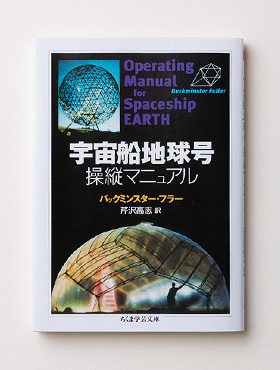


 Operating Manual for Spaceship Earth
Operating Manual for Spaceship EarthWritten by Richard Buckminster Fuller (translated by Takashi Serizawa)

Sometimes an introduction to a new person leads to an introduction to a new book.
I was introduced to Operating Manual for Spaceship Earth by MARUI GROUP Sustainability Advisor Peter David Pedersen. In my conversations with Mr. Pedersen, the name of this book's author, Richard Buckminster Fuller, came up many times. Mr. Pedersen did not particularly pay much attention to this, but I did.
The first time I heard of Fuller, as I recall, was during Japan’s bubble period in the late 1980s. When people think of the bubble period, they tend to think of a time of extreme affluence. What is interesting, however, was that Japan’s bubble period was also a period during which we saw an increased push to address environmental issues, which coincides with the trend toward sustainability of today. Amid the economic frenzy extending to money, land, and stocks, Fuller and his book, Operating Manual for Spaceship Earth, had quite a following. In fact, the easy-to-understand term of "Spaceship Earth" gained popularity as a synonym for the fight against environmental issues. (It somehow caught on along with the brands, discos, and the Nissan Cima that were popular at the time.) I wasn't very fond of the term "Spaceship Earth" at that time, however. It seemed childish to me, and the idea of comparing the earth, which itself is alive with its various ecosystems, including those involving humans, to a spaceship did not resonate with me. What did stick with me was the name of Fuller, which remained in the back of my mind from that time on. (I have a thing for cool sounding names, like Wittgenstein or Rohan.)
One day, nearly three decades after the collapse of Japan's bubble economy, I once again heard the name of Fuller during a conversation with Mr. Pedersen. Sensing it was fate, I decided to read Operating Manual for Spaceship Earth. It was much more interesting than I had anticipated, and I couldn’t put it down. The content differed from what I had expected from the title. In fact, the book jumped from topic to topic and did not follow conventional story structures. If asked for a summary, I would not know what to say. (For this reason, some may find the book hard to decipher.) Despite this difficulty, I found myself captivated by Fuller’s vision as each of the ongoing stream of ideas, concepts, and images was surprising and striking. I was most struck by the following passage.
"Now we can account wealth more precisely as the number of forward days for a specific number of people we are physically prepared to sustain..."
Fuller, whom I now consider to be an important teacher to me, flips the idea of “wealth” on its head. To Fuller, wealth is not about money, land, or a Mercedes Benz, but rather about the number of forward days we can prepare for our children and for future generations. I could not help but be struck with admiration with the power and the precision of this definition.
I have always had a high degree of concern for environmental issues, but there was previously something about these issues that didn’t click with me. People often use phrases like “being friendly to the earth” and "preserving the environment," but I was dubious of our ability to “be friendly to the earth” and "preserve the environment." I wondered if the earth or the environment wanted the protection of people. In business terms, I questioned whether the environment could be counted among a company’s stakeholders like customers, shareholders, and employees. These troubling questions vanished when I was introduced to the idea of the number of forward days we can prepare. The stakeholder we serve when we address environmental issues was, in fact, future generations. Mr. Pedersen had hinted at this concept in the past when he told us:
"Companies must develop inter-generational businesses."
However, these words created another question that I struggled with: What type of businesses will link us to children and to future generations? This question was resolved when I encountered Fuller’s idea of the number of forward days we can prepare. This idea made me realize that addressing environmental issues was itself the act of developing inter-generational businesses.
I must apologize to Fuller as I actually omitted part of his passage earlier. The full passage is: "Now we can account wealth more precisely as the number of forward days for a specific number of people we are physically prepared to sustain at a physically stated time and space liberating level of metabolic and metaphysical regeneration" (previously omitted portion underlined). This omission was based on my concern that the use of difficult terms such as "metabolic and metaphysical regeneration" would cause confusion and result in the most important part of the message being lost. Some might reprimand such an omission, saying that it no longer constitutes a quotation, and it is more like I made up the statement myself. However, I am content to be subjected to such criticism. This is because my reading Fuller’s book constitutes engagement with Fuller, and this engagement is also connected to my engagement with Mr. Pedersen.
Reading a book is truly an act of engagement. Not only engagement with the author, reading can stimulate engagement with friends and associates and with oneself. I hope you will enjoy the opportunity for engagement with Fuller and with yourself by reading Operating Manual for Spaceship Earth.
- Operating Manual for Spaceship Earth (Japanese-language version)
- Written by Richard Buckminster Fuller (translated by Takashi Serizawa)Chikumashobo Ltd.October 1, 2000
-
Purchase on Amazon
 Purchase on Rakuten Books (Japanese only)
Purchase on Rakuten Books (Japanese only)
- Hiroshi Aoi
- President and Representative Director
Representative Executive Officer, CEO

